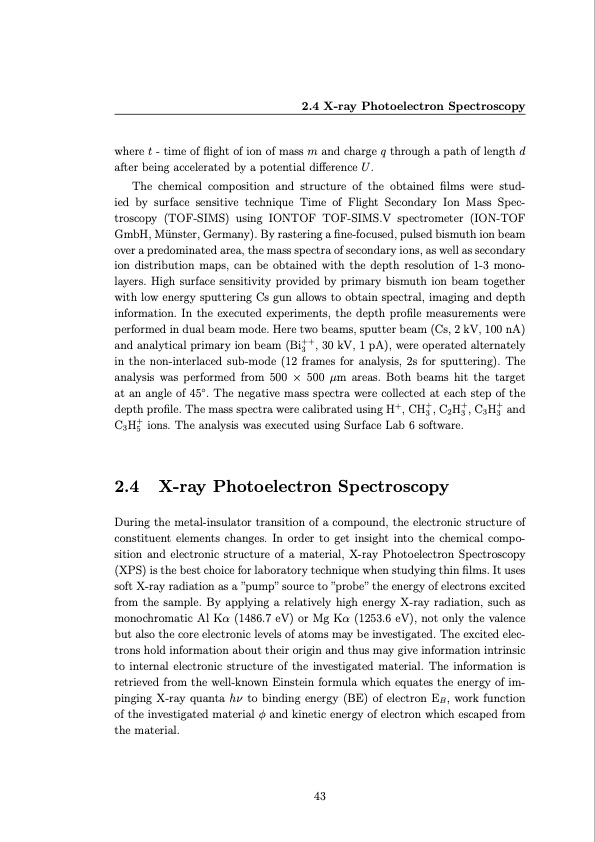
PDF Publication Title:
Text from PDF Page: 064
2.4 X-ray Photoelectron Spectroscopy where t - time of flight of ion of mass m and charge q through a path of length d after being accelerated by a potential difference U. The chemical composition and structure of the obtained films were stud- ied by surface sensitive technique Time of Flight Secondary Ion Mass Spec- troscopy (TOF-SIMS) using IONTOF TOF-SIMS.V spectrometer (ION-TOF GmbH, Mu ̈nster, Germany). By rastering a fine-focused, pulsed bismuth ion beam over a predominated area, the mass spectra of secondary ions, as well as secondary ion distribution maps, can be obtained with the depth resolution of 1-3 mono- layers. High surface sensitivity provided by primary bismuth ion beam together with low energy sputtering Cs gun allows to obtain spectral, imaging and depth information. In the executed experiments, the depth profile measurements were performed in dual beam mode. Here two beams, sputter beam (Cs, 2 kV, 100 nA) and analytical primary ion beam (Bi++, 30 kV, 1 pA), were operated alternately 3 in the non-interlaced sub-mode (12 frames for analysis, 2s for sputtering). The analysis was performed from 500 × 500 μm areas. Both beams hit the target at an angle of 45◦. The negative mass spectra were collected at each step of the depth profile. The mass spectra were calibrated using H+, CH+3 , C2H+3 , C3H+3 and C3H+5 ions. The analysis was executed using Surface Lab 6 software. 2.4 X-ray Photoelectron Spectroscopy During the metal-insulator transition of a compound, the electronic structure of constituent elements changes. In order to get insight into the chemical compo- sition and electronic structure of a material, X-ray Photoelectron Spectroscopy (XPS) is the best choice for laboratory technique when studying thin films. It uses soft X-ray radiation as a ”pump” source to ”probe” the energy of electrons excited from the sample. By applying a relatively high energy X-ray radiation, such as monochromatic Al Kα (1486.7 eV) or Mg Kα (1253.6 eV), not only the valence but also the core electronic levels of atoms may be investigated. The excited elec- trons hold information about their origin and thus may give information intrinsic to internal electronic structure of the investigated material. The information is retrieved from the well-known Einstein formula which equates the energy of im- pinging X-ray quanta hν to binding energy (BE) of electron EB, work function of the investigated material φ and kinetic energy of electron which escaped from the material. 43PDF Image | Investigation of metal-insulator transition in magnetron sputtered samarium nickelate thin films

PDF Search Title:
Investigation of metal-insulator transition in magnetron sputtered samarium nickelate thin filmsOriginal File Name Searched:
Bilewska_Investigation_of_metal_insulator_transition_in_magnetron_sputtered_samarium.pdfDIY PDF Search: Google It | Yahoo | Bing
Sulfur Deposition on Carbon Nanofibers using Supercritical CO2 Sulfur Deposition on Carbon Nanofibers using Supercritical CO2. Gamma sulfur also known as mother of pearl sulfur and nacreous sulfur... More Info
CO2 Organic Rankine Cycle Experimenter Platform The supercritical CO2 phase change system is both a heat pump and organic rankine cycle which can be used for those purposes and as a supercritical extractor for advanced subcritical and supercritical extraction technology. Uses include producing nanoparticles, precious metal CO2 extraction, lithium battery recycling, and other applications... More Info
| CONTACT TEL: 608-238-6001 Email: greg@infinityturbine.com | RSS | AMP |